5 of the most amazing rock formations on Earth
by Scott Dutfield · 26/06/2020
1. Devils Tower
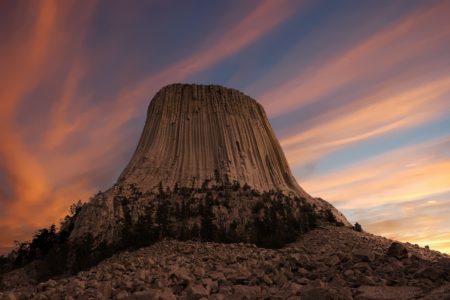
Towering above the trees of the Black Hills National Forest, this colossal monument appears to have sprouted straight from the underworld. The imposing geological formation is, in fact, the world’s largest example of columnar jointing. From base to summit, Devils Tower reaches 264 metres high and is comprised of many three-metre-wide hexagonal columns.
Born from the flames of the Earth’s core, geologists agree that this monument burst through our planet’s crust as magma and cooled close to the surface. It is this cooling process that gives the rocks their unique geometry. As the igneous rock cools down it begins to contract around stress points, and over time the pressure builds around these points. As a result tessellating cracks form distinctive hexagonal shapes that release the pressure, running from the top to the bottom and forming the structure’s multi-column architecture.
Although geologists have agreed on how columnar jointing forms, the unusual grandeur of Devils Tower has still got them scratching their heads.
2. Antelope Canyon
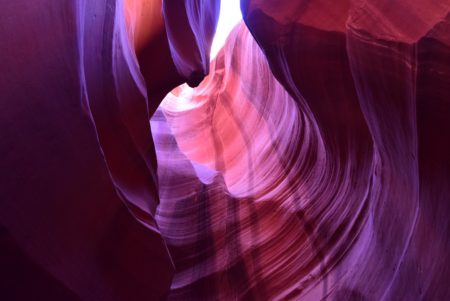
On the surface Antelope Canyon might not seem that impressive. However, deep between the cavernous cracks of this sandstone landscape is an intricate network of pathways boasting beautiful colours.
Because of its sedimentary composition, sandstone is highly susceptible to erosion and is easily carved into structures and shapes. Antelope Canyon is no exception. It’s around 37 metres below the surface, and over millennia flash floods and strong winds carrying loose sediment have worn away at the sandstone to form what is referred to as a slot canyon.
Known for is the ability to transport visitors to a sandy subterranean world, Antelope Canyon is also flooded with an array of vibrant colours. Sandstone naturally appears red due to its high iron content. However, at the Antelope Canyon, the shape of slots allow the incoming light to bounce off its quartz-filled walls at different angles. This creates tonal changes in the colours that are reflected between each canyon crack. Vibrant reds at the entrance of a crack can descend into a spectrum of oranges, yellows, pinks and purples by the time the light reaches the floor of the canyon.
3. Wave Rock
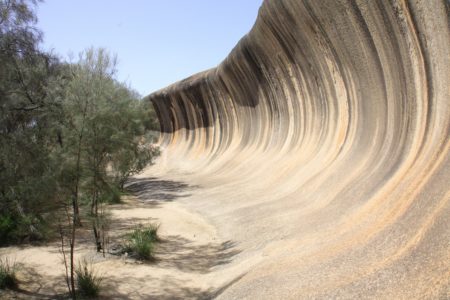
Australia is well known as one of the word’s prime locations to surf the perfect wave. And near the town of Hyden is a wave 110 metres long. There’s only one problem: it’s made of solid rock.
Towering 15 metres into the air, this granite cliff, called Wave Rock, formed over 2,500 million years ago. As one side of an inselberg (an isolated hill or mountain rising from a plain), this concave cliff is known as a ‘flared slope’.
Created by wind and rain erosion, it is comprised of coarse-grained porphyritic granite and igneous rock embedded with different minerals and crystals. As wind and rain has battered the wall, softer rock at the base has been undercut, producing its wave-like appearance.
Rainfall has not only helped to create the rock formation’s shape but has also decorated it with a series of red, brown and yellow stripes. Although they might seem hand-painted, each vertical stripe is an indication of different mineral deposits washed down the slope, reacting with the water and producing different colours.
Water-loving algae also play a role in the cliff’s colourisation. Usually staining the rock black, these tiny organisms develop a brownish colour during the dry seasons.
4. Rocky Forest
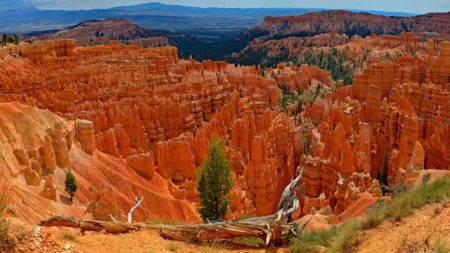
In the western US state of Utah, Bryce Canyon National Park is a red wonderland filled with rocky forests. Spanning as far as the eye can see, towering spires of undulating rock appear to have sprung from the ground below.
Like many of the other awe-inspiring formations in this feature, these unusual peaks are the result of millions of years of erosion. Once a giant plateau (a flat plain high above the ground), over time the elements have chipped away at it, slowly dissolving its landscape into these rocky statues, known as hoodoos.
This forest of stone has come to exist because of the irregular rate of the plateau’s erosion. Made up of different layers of rock, plateaus form over millions of years, as sediment and rock piles up as a result of deposition or volcanic eruption. Each has different properties: some rocks, such as mudstone, react more quickly to erosion, while other layers of more dense rock, such as limestone, erode more slowly. This irregularity of erosion rates is known as ‘differential erosion’ and results in the formation of the hoodoo’s spires.
5. Chocolate Hills
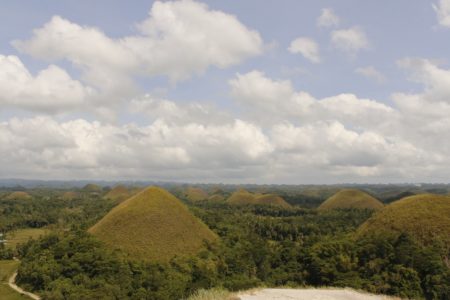
Many mountains and hills form by rising out of the ground over millions of years, but the Chocolate Hills appeared after the world melted away around them. Mountains typically form from solidified magma that has been forced to the surface or as the result of two continents crashing into one another. But in some cases, mountains and other geological formations touch the skies in what are known as karsts.
Karsts are an area of land where the rocky foundations, typically limestone, have been eroded by heavy rainfall and groundwater. Formed from ancient compacted marine organic matter (such as tiny fossilised crustaceans), calcium-rich limestone is an easily dissolvable material. Continued erosion by water slowly creates caves and sinkholes, which causes the limestone at the surface to collapse. In turn, the surface topography changes, revealing mounds where patches of land haven’t sunk.
There are many examples of karsts across the globe, some hosting more dramatic and irregular hills hundreds of metres tall. What makes the Chocolate Hills so unique is their repetition and smooth appearance. Around 1,260 to 1,776 of these almost dome-shaped hills are spread across the region, ranging in height from 30 to 120 metres tall.
This article was originally published in How It Works issue 131
For more science and technology articles, pick up the latest copy of How It Works from all good retailers or from our website now. If you have a tablet or smartphone, you can also download the digital version onto your iOS or Android device. To make sure you never miss an issue of How It Works magazine, subscribe today!




